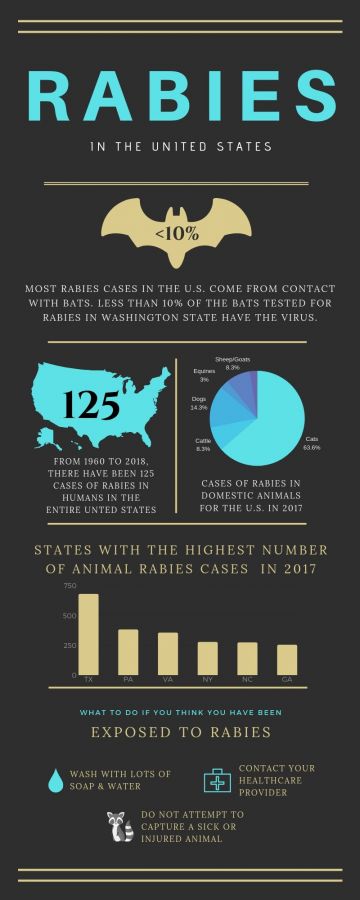Which animals in Washington State typically carry rabies?
While rabies is a worldwide disease, there are animals in Washington state that are more likely to carry the disease than others. In this article, we explore the causes, transmission, and treatment of rabies.
What is rabies?
Rabies is a serious viral disease transmitted via mammals, from bites or scratches. Salivary contact with eyes, nose or mouth can also spread the virus. The disease cannot be  contracted by simple fecal, urine of blood contact, or by petting an infected animal. Rabies affects the nervous system and causes inflammation of the brain. Once symptoms appear, the disease usually causes death.
contracted by simple fecal, urine of blood contact, or by petting an infected animal. Rabies affects the nervous system and causes inflammation of the brain. Once symptoms appear, the disease usually causes death.
Typically, when we think of rabies, we think of crazed, aggressive animals foaming at the mouth – remember Cujo? There are two forms of rabies – “furious” and “dumb”, or paralytic. While some animals who are infected with furious rabies do behave aggressively, and have more violent signs, most infected animals just look and act sick, drool, or have very little energy. Sometimes wild animals can behave in a very docile or even tame manner. They can become less afraid of humans, which can result in many behavioral changes. Basically, if an animal is behaving strangely, maintain your distance and contact an animal control specialist.
How can people catch rabies?
On a global level, dogs are the number one vector for transmission of rabies to humans. Almost all worldwide cases of rabies occur due to dog bites. In the United States and the Americas, bat bites account for over 95% of human infections. This is due to the U.S. programs started in the 1950s that emphasized vaccinating dogs against rabies and instituted leash laws preventing accidental exposure.
In Washington State, rabid bats are found in just about every county. Although less than 10% of bats sent for testing have proven to be rabid. It is estimated that less than 1% of the wild bat population is infected with rabies. Bat bites usually occur when a person (or animals) attempts to pick up a bat that appears sick, injured, or even dead.
While any warm-blooded animals can carry the virus, some other commonly infected species that humans may closely encounter are raccoons, skunks, foxes and coyotes. Transmission between humans is extremely rare.
The US Department of Agriculture runs a program that vaccinates wild animals such as coyotes and raccoons by dropping bait packets containing an oral vaccine. Animals consume the bait and are then protected against contracting the virus. This program does not affect bats, unfortunately.
What are the symptoms of rabies in humans?
Common initial symptoms of rabies include fever and headache. As the inflammation of the brain progresses, signs such as delirium, insomnia, confusion, paranoia and hallucinations can appear. Hydrophobia, or fear of water, occurs in some cases. This is due to the virus multiplying in the salivary glands (which is why bites spread the disease) and resulting in painful spasms of the muscles in the larynx and throat. The victim may panic when offered liquids, has difficulty swallowing, and cannot satisfy their thirst.
For a human who has potentially been infected, the rabies immunoglobulin (antibodies) and rabies vaccine must be given before symptoms begin. The interval between contracting the disease and exhibition of symptoms can happen as quickly as one week, or as take long as one year, but typically runs between one to three months. There are documented instances when the symptoms have shown after only four days. Only 14 people have been known to have survived after the symptoms had started. (statistics current as of 2016). In unvaccinated persons, once the neurological symptoms develop, the disease is almost always fatal.
How likely is it that I will catch rabies? What do I do if I’m bitten?
Overall, humans rarely contract rabies in the United States – usually one to seven cases annually. From 1960 to 2018, there were a total of 125. Over a third of these were caused by dog bites received in other countries. From those that resulted from animal contact on this country, 70% were due to contact with bats. In Washington State, there have been two cases reported in the last 25 years, both also resulting from contact with bats. During the same 25-year period, four domestic animals have been infected with rabies – a cat, a dog, a horse, and a llama.
However, if you are travelling abroad to countries where dog rabies is common, consider obtaining a vaccination beforehand, especially if you will be in more remote areas without adequate health care options. The majority of deaths due to rabies happen in Asia and Africa, mostly in India, China, and the DRC.
Rabies is preventable in every case if quick medical care is given. An immediate step is to thoroughly wash the area with soap and water for at least five minutes. Apply alcohol or iodine afterwards, if available. After this, if rabies exposure is assumed or diagnosed, the victim will receive one dose of the immunoglobulin and four doses of the vaccine over the next 14 days. If applied with minimal delay, these methods provide a 100% success rate. Those few victims who die from rabies do so because they did not seek immediate treatment.
Resources
The Global Rabies Alliance seeks to eliminate canine rabies by 2030. For more information, visit them at https://rabiesalliance.org/.
The Center for Disease Prevention website at https://www.cdc.gov/rabies/location/usa/surveillance/human_rabies.html
Washington State Department of Health https://www.doh.wa.gov/YouandYourFamily/IllnessandDisease/Rabies
Enjoy our blog? follow us on Facebook.
Published on July 22, 2019
